“Global Laser Diode Market to reach a market value of USD 15.6 Billion by 2030 growing at a CAGR of 12.8%”
The Global Laser Diode Market size is expected to reach $15.6 billion by 2030, rising at a market growth of 12.8% CAGR during the forecast period.
The heterostructure design of these lasers reduces optical losses, leading to higher optical efficiency and better overall performance. Thus, the Double Hetero Structure segment acquired $897.7 million in 2022. DH lasers exhibit improved temperature stability compared to homojunction lasers, making them suitable for harsh environments and applications requiring stable operation over a wide temperature range.
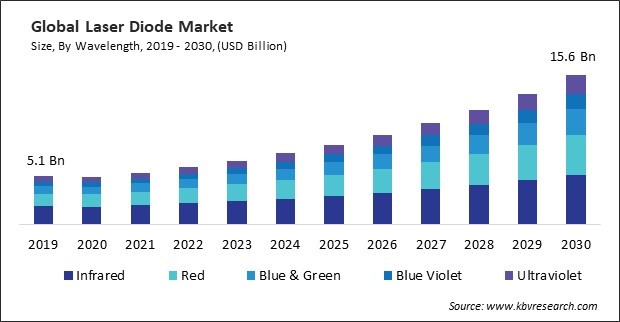
The major strategies followed by the market participants are Product Launches as the key developmental strategy to keep pace with the changing demands of end users. For instance, In January 2024, Ushio, Inc. has introduced high-power red laser diodes boasting the world's highest optical output power of 4.2 W in pulsed mode. The HL63680HD achieves this feat even at high temperatures of 45°C, with an unmatched wall-plug efficiency of 45% in 638 nm pulsed operation at 25°C. Additionally, In January 2024, Jenoptik AG has launched a new single-bar diode laser package, LS, designed for optically pumping next-generation solid-state lasers. The LS incorporates an enhanced cooling system, utilising a double-sided open heat sink design for improved heat dissipation.
Based on the Analysis presented in the KBV Cardinal matrix; Rohm Semiconductors Co., Ltd., MKS Instruments, Inc. and Hamamatsu Photonics K.K. are the forerunners in the Market. In July 2023, MKS Instruments, Inc. unveiled the Ophir Beam Watch Plus, a novel product designed for non-contact beam profiling to gauge focus shift. The BeamWatch Plus system employs high-magnification optics capable of measuring beams with spot sizes as small as 45µm, enabling finer, more accurate cuts and minimising material waste. Companies such as IPG Photonics Corporation, Ushio, Inc, Jenoptik AG are some of the key innovators in Market.
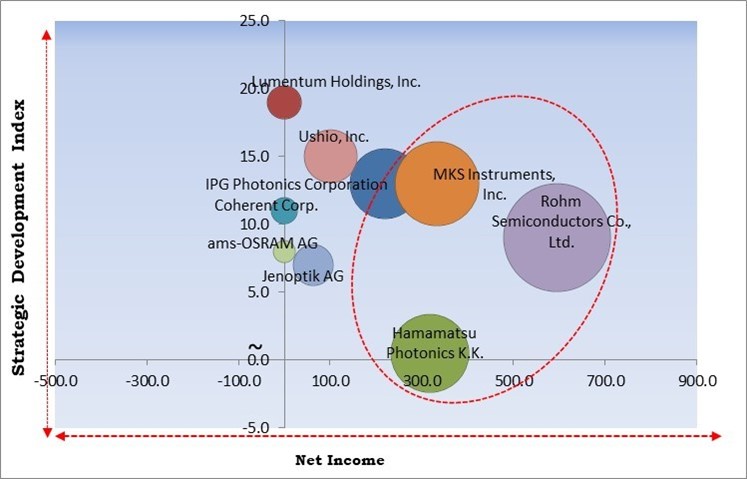
Laser diodes have become indispensable tools in automotive, aerospace, and electronics manufacturing industries due to their ability to deliver high precision and energy efficiency. Thus, as industries evolve and demand more advanced manufacturing solutions, the demand for laser diodes will increase.
Additionally, Laser diodes are integral to various consumer electronic devices, including smartphones, tablets, and laptops. Therefore, as these trends continue to evolve, the consumer electronics sector is expected to grow further, offering new opportunities for innovation and expansion for the market.
The high costs are primarily driven by the complexity and precision required in manufacturing laser diodes and the advanced technologies and materials used in their production. This, in turn, can slow the development of new applications and solutions that could benefit from laser diode technology. Thus, the high costs of these systems may hamper the market's growth in the coming years.
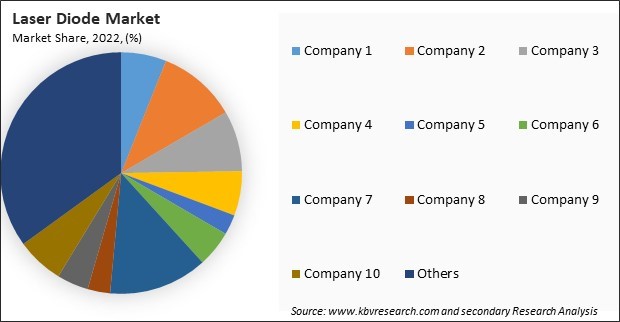
The leading players in the market are competing with diverse innovative offerings to remain competitive in the market. The above illustration shows the percentage of revenue shared by some of the leading companies in the market. The leading players of the market are adopting various strategies in order to cater demand coming from the different industries. The key developmental strategies in the market are Product Launches and Product Expansions.
Based on wavelength, the market is classified into infrared, red, blue & green, blue violet, and ultraviolet. The blue & green segment recorded a promising 16% revenue in the market in 2022. Blue and green laser diodes are used in biomedical and medical applications, such as photodynamic therapy, fluorescence microscopy, and ophthalmology.
Based on technology, the market is categorized into double hetero structure, quantum well & cascade, distributed feedback, separate confinement heterostructure (SCH), and vertical cavity surface emitting laser (VCSEL) & vertical external cavity surface emitting laser (VECSEL). The distributed feedback segment acquired a 37.3% revenue share in the market in 2022.
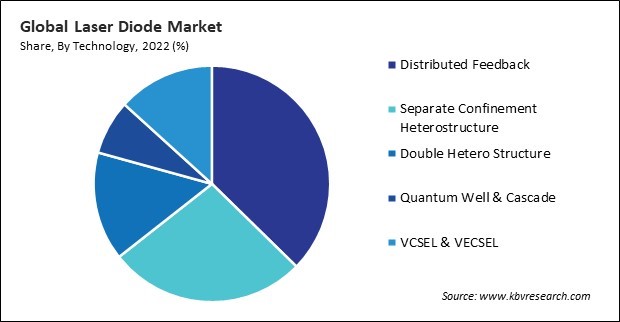
On the basis of doping material, the market is segmented into gallium arsenide (GaAs), gallium aluminum arsenide (GaAIAs), gallium nitride (GaN) & indium gallium nitride (InGaN), gallium indium arsenic antimony (GaInAsSb), aluminum gallium indium phosphide (AIGaInP), and others. The gallium indium arsenic antimony (GaInAsSb) segment procured a 12% revenue in the market in 2022.
On the basis of end use, the market is divided into telecommunication, industrial & automotive, medical & healthcare, consumer electronics, and others. The consumer electronics segment procured 35% revenue share in the market in 2022. They provide accurate depth sensing capabilities, enabling advanced features and functionalities.
Free Valuable Insights: Global Laser Diode Market size to reach USD 15.6 Billion by 2030
Region-wise, the market is analyzed across North America, Europe, Asia Pacific, and LAMEA. The Asia Pacific region dominated the market with a 36.2% revenue share in 2022. Certain manufacturing powerhouses of global significance are located in the Asia-Pacific region, most notably in Japan, South Korea, China, and Taiwan.
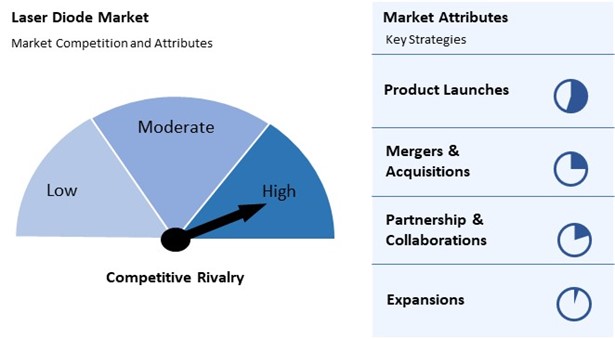
The Laser Diode market is fiercely competitive, with several key players striving for dominance. Major companies such as Coherent Inc., IPG Photonics Corporation, and Rohm Semiconductors Co., Ltd. are prominent contenders, offering a wide range of laser diode products catering to various industries and applications. Additionally, companies like Hamamatsu Photonics, MKS Instruments, Inc., and Jenoptik AG contribute significantly to the competition with their innovative technologies and product offerings. Competition in the Laser Diode market is driven by factors such as technological advancements, product performance, pricing strategies, and customer service.
| Report Attribute | Details |
|---|---|
| Market size value in 2022 | USD 6 Billion |
| Market size forecast in 2030 | USD 15.6 Billion |
| Base Year | 2022 |
| Historical Period | 2019 to 2021 |
| Forecast Period | 2023 to 2030 |
| Revenue Growth Rate | CAGR of 12.8% from 2023 to 2030 |
| Number of Pages | 379 |
| Number of Tables | 534 |
| Report coverage | Market Trends, Revenue Estimation and Forecast, Segmentation Analysis, Regional and Country Breakdown, Competitive Landscape, Market Share Analysis, Porter’s 5 Forces Analysis, Company Profiling, Companies Strategic Developments, SWOT Analysis, Winning Imperatives |
| Segments covered | Wavelength, Technology, Doping Material, End Use, Region |
| Country scope |
|
| Companies Included | Coherent Corp., IPG Photonics Corporation, Jenoptik AG, Lumentum Holdings, Inc., MKS Instruments, Inc., ams-OSRAM AG, Rohm Semiconductors Co., Ltd., Sharp Corporation, Ushio, Inc., Hamamatsu Photonics K.K. |
By Wavelength
By Technology
By Doping Material
By End Use
By Geography
The Market size is projected to reach USD $15.6 billion by 2030.
Increasing adoption of laser diodes in industrial applications are driving the Market in coming years, however, Significant competition from other technologies restraints the growth of the Market.
Coherent Corp., IPG Photonics Corporation, Jenoptik AG, Lumentum Holdings, Inc., MKS Instruments, Inc., ams-OSRAM AG, Rohm Semiconductors Co., Ltd., Sharp Corporation, Ushio, Inc., Hamamatsu Photonics K.K.
The Infrared segment is generating the highest revenue in the Global Laser Diode Market by Wavelength in 2022; thereby, achieving a market value of $5.3 billion by 2030.
The Gallium Arsenide (GaAs) segment is leading the Market by Doping Material in 2022; thereby, achieving a market value of $4.7 billion by 2030.
The Asia Pacific region dominated the Market by Region in 2022, and would continue to be a dominant market till 2030; thereby, achieving a market value of $5.7 billion by 2030.
Our team of dedicated experts can provide you with attractive expansion opportunities for your business.
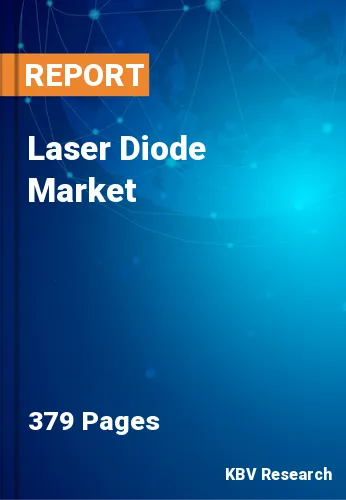
 Drivers
Drivers
 Restraints
Restraints
 Opportunities
Opportunities
 Challenges
Challenges
